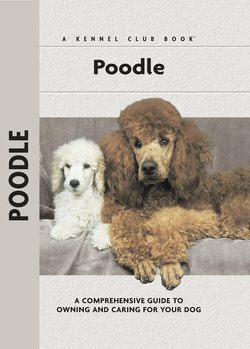Читать книгу Poodle - S. Meyer Clark - Страница 10
На сайте Литреса книга снята с продажи.
THE POODLE ARRIVES IN AMERICA
ОглавлениеIt was inevitable that, from England, Poodles would find their way to America. They did so in 1887. Prior to World War I, Poodle popularity reached a peak at American dog shows. Originally, Standards and Miniatures in America were shown as a single breed, and Toys were shown as a separate breed prior to World War II.
The Poodle was, at one time, one of the world’s most popular dogs, especially with lady fanciers. Consequently, breeders vied with one another to develop the coat, which ranged from thick curls to long but orderly cords. This photo, dated 1899, shows a typical high-quality corded Poodle. The corded coat is much less common than the curly coat.
The Poodle Club of America, founded in 1931 to govern the standard of perfection for all Poodles, offered classes with the same criteria for all three sizes. As a matter of fact, the first Miniature to earn an American championship title was the black English dog named Ch. Chieveley Chopstick.
Some of England’s finest Poodles as well as several from the Continent were imported to America during the early 1900s. Their genetic heritage still carries on today, and we often see the names of well-known English dogs in the pedigrees of modern American Poodles.
By 1960, America had caught up with the British and European interest in the breed. Poodles became the most popular breed of dog in American Kennel Club registration statistics. They have maintained the status of being among the ten most popular breeds ever since.
Miss Jane Lane, who made a considerable positive impact on the Poodle fancy through her Nunsoe kennels, is shown with her favorites, Int. Ch. Nunsoe Duc de la Terrace and Ch. Nunsoe Lady Mary.
Reserve Best in Show and winner of the Group at the Royal Show in Sydney, Australia was Standard Poodle Aust. Ch. Troymere Believe in Me. This is what a modern champion looks like.
The famed Poodle breeder, Miss Florence Brunker, though well-known for her excellent Poodles, was also famous for her extravagant hats. She prided herself in having hats larger than her dogs, or, alternatively, having dogs smaller than her hats.
One reason for the Poodle’s elite standing in dogdom is the breed’s affinity for obedience competition. Aside from excelling in the conformation show ring, Poodles love attention, and performing in obedience to please their owners and others is a terrific way of getting attention.
In the 1930s, Helen Whitehouse Walker, owner of Carillon Kennels, wanted to introduce the sport of obedience into America. She was tired of hearing people say that Poodles, with their fancy hairdos, were vanity dogs. She vowed to prove the Poodle’s intelligence and trainability to America.
This smartly trimmed black Standard will be taking a ribbon home for his equally smartly dressed handler.
In 1934, as England was enjoying the growing sport of obedience trialing, Mrs. Walker went to Great Britain to study the sport and the training methods for obedience. When she returned home to America, she shared what she had learned with others, including her dear friend, Blanche Sauders, who ultimately became a renowned obedience exhibitor and teacher.
By 1947, America was ready to recognize obedience competition. The American Kennel Club officially adopted the rules and regulations for the sport and established an obedience department within its ranks.
From the working Poodle-like dogs of Europe in the 12th century to the sophisticated Poodles of the 21st century, the breed maintains its ancestral traits that endear it to people around the world. Thus, centuries after the breed’s development, there seems no reason to believe that Poodles will be any less popular in the future than they have been in the past.
Standard Poodle being gaited around the ring. The evaluation of a dog’s movement determines how well-constructed the animal is.
